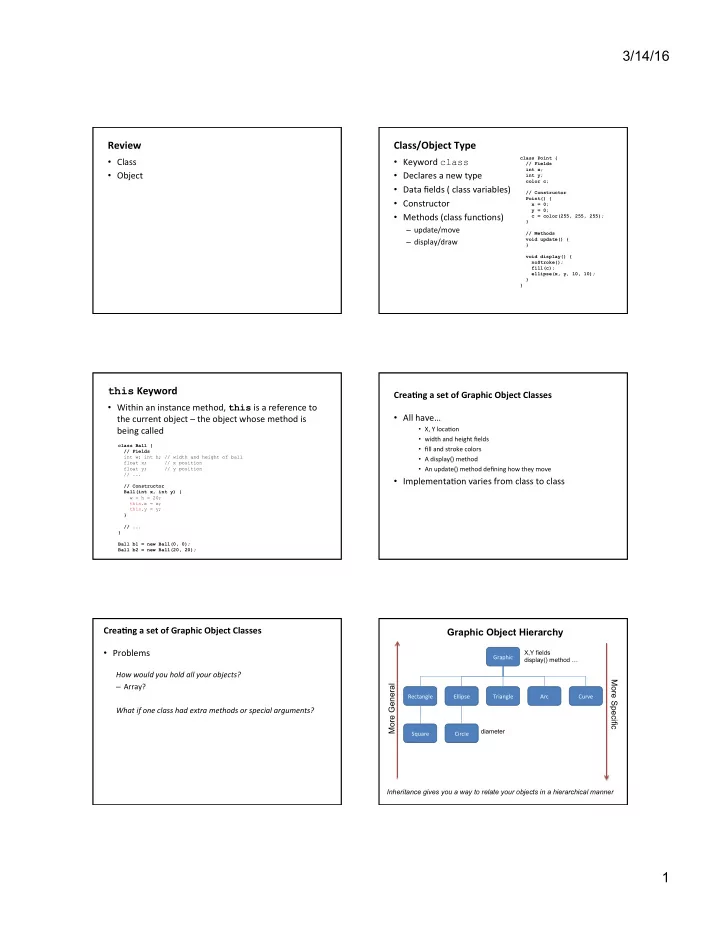

3/14/16 Review ¡ Class/Object ¡Type ¡ • Class ¡ • Keyword ¡ class class Point { // Fields int x; • Object ¡ • Declares ¡a ¡new ¡type ¡ int y; color c; • Data ¡fields ¡( ¡class ¡variables) ¡ // Constructor Point() { • Constructor ¡ x = 0; y = 0; • Methods ¡(class ¡func>ons) ¡ c = color(255, 255, 255); } – update/move ¡ // Methods – display/draw ¡ void update() { } void display() { noStroke(); fill(c); ellipse(x, y, 10, 10); } } this ¡Keyword ¡ Crea8ng ¡a ¡set ¡of ¡Graphic ¡Object ¡Classes ¡ • Within ¡an ¡instance ¡method, ¡ this ¡is ¡a ¡reference ¡to ¡ • All ¡have… ¡ the ¡current ¡object ¡– ¡the ¡object ¡whose ¡method ¡is ¡ being ¡called ¡ • X, ¡Y ¡loca>on ¡ • width ¡and ¡height ¡fields ¡ class Ball { • fill ¡and ¡stroke ¡colors ¡ // Fields int w; int h; // width and height of ball • A ¡display() ¡method ¡ float x; // x position • An ¡update() ¡method ¡defining ¡how ¡they ¡move ¡ float y; // y position // ... • Implementa>on ¡varies ¡from ¡class ¡to ¡class ¡ // Constructor Ball(int x, int y) { w = h = 20; this.x = x; this.y = y; } // ... } Ball b1 = new Ball(0, 0); Ball b2 = new Ball(20, 20); Crea8ng ¡a ¡set ¡of ¡Graphic ¡Object ¡Classes ¡ Graphic Object Hierarchy • Problems ¡ X,Y fields Graphic ¡ display() method … How ¡would ¡you ¡hold ¡all ¡your ¡objects? ¡ More Specific More General – Array? ¡ Rectangle ¡ Ellipse ¡ Triangle ¡ Arc ¡ Curve ¡ What ¡if ¡one ¡class ¡had ¡extra ¡methods ¡or ¡special ¡arguments? ¡ diameter Square ¡ Circle ¡ Inheritance gives you a way to relate your objects in a hierarchical manner 1
3/14/16 // Ellipse base class // Circle derived class class Ellipse { class Circle extends Ellipse { Inheritance ¡ float X; float Y; Circle(float X, float Y, float D) { float W; super (X, Y, D, D); • Superclass ¡(parent ¡class) ¡– ¡higher ¡in ¡the ¡hierarchy ¡ float H; // Circles are always green • Subclass ¡(child ¡class) ¡– ¡lower ¡in ¡the ¡hierarchy ¡ // Ellipses are always red fillColor = color(0,255,0); color fillColor = } } • A ¡subclass ¡is ¡ derived ¡from ¡ from ¡a ¡superclass ¡ color(255,0,0); • Subclasses ¡ inherit ¡the ¡ fields ¡and ¡ methods ¡of ¡their ¡ Ellipse(float X, float Y, • The ¡ extends ¡keyword ¡creates ¡ float W, float H){ hierarchical ¡rela>onship ¡between ¡ superclass. ¡ this .X = X; classes. ¡ this .Y = Y; – I.e. ¡subclasses ¡automa>cally ¡ "get" ¡ stuff ¡in ¡superclasses ¡ this .W = W; • The ¡Circle ¡class ¡gets ¡all ¡fields ¡and ¡ this .H = H; • Subclasses ¡can ¡ override ¡a ¡superclass ¡method ¡by ¡ methods ¡of ¡the ¡Ellipse ¡class, ¡ } automa>cally. ¡ redefining ¡it. ¡ void display() { • The ¡ super ¡keyword ¡refers ¡to ¡the ¡base ¡ ellipseMode(CENTER); – They ¡can ¡replace ¡anything ¡by ¡redefining ¡locally ¡ fill(fillColor); class ¡in ¡the ¡rela>onship. ¡ ellipse(X, Y, W, H); } • The ¡ this ¡keyword ¡refers ¡to ¡the ¡object ¡ } itself. ¡ Graphics.pde // Graphics // Graphics2 Ellipse e = new Ellipse(150, 250, 150, 50); Ellipse[] es = new Ellipse[20]; Circle c = new Circle(350, 250, 75); void setup() { size(500, 500); void setup() { size(500, 500); for (int i=0; i< es.length; i++) { } float X = random(0, width); float Y = random(0, height); void draw() { float W = random(10, 100); e.display(); float H = random(10, 100); c.display(); // Ellipses and Circles are } // stored in the same array if (random(1.0) < 0.5) es[i] = new Ellipse(X,Y,W,H); else es[i] = new Circle(X,Y,W); } } void draw() { for (int i=0; i<es.length; i++) es[i].display(); } Ellipses and Circles in the same array! Graphics2.pde Graphics.pde // Circle derived class // Ellipse base class class Ellipse { class Circle extends Ellipse { float X; // Graphics3 float Y; Circle(float X, float Y, float D) { Ellipse[] es = new Ellipse[20]; float W; super(X, Y, D, D); float H; // Circles are always green void setup() { // Ellipses are always red fillColor = color(0,255,0); size(500, 500); color fillColor = } //code now shown … color(255,0,0); } // Change color of circle when clicked void mousePressed() { Ellipse(float X, float Y, if (dist(mouseX, mouseY, X, Y) < 0.5*W) void draw() { float W, float H){ fillColor = color(0,0,255); for (int i=0; i<es.length; i++) this.X = X; this.Y = Y; } es[i].display(); this.W = W; } } this.H = H; } void mousePressed() { • The ¡mousePressed ¡behavior ¡of ¡the ¡ for (int i=0; i<es.length; i++) void display() { es[i].mousePressed(); ellipseMode(CENTER); Circle ¡class ¡ overrides ¡the ¡default ¡ fill(fillColor); } behavior ¡of ¡the ¡Ellipse ¡class. ¡ ellipse(X, Y, W, H); } // Do nothing void mousePressed() {} } Graphics3.pde Graphics3.pde 2
3/14/16 Example ¡ A ¡few ¡more ¡rules ¡about ¡inheritance ¡… ¡ • ballDropInheritance ¡ • A ¡child’s ¡constructor ¡is ¡responsible ¡for ¡calling ¡the ¡ parent’s ¡constructor ¡ • The ¡first ¡line ¡of ¡a ¡child’s ¡constructor ¡should ¡use ¡the ¡ super ¡reference ¡to ¡call ¡the ¡parent’s ¡constructor ¡ • The ¡ super ¡reference ¡can ¡also ¡be ¡used ¡to ¡reference ¡ other ¡variables ¡and ¡methods ¡defined ¡in ¡the ¡parent’s ¡ class ¡ 3
Recommend
More recommend